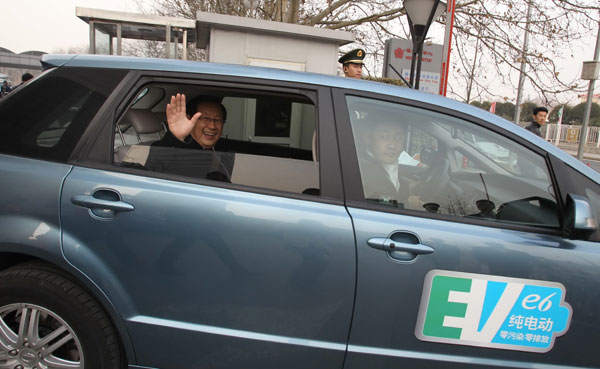Research to focus on people's livelihoods
|
 |
|
Minister of Technology and Science Wan Gang leaves in an electric car after a news conference during the annual sessions of the top legislature and political advisory body on Thursday. [Zhu Xingxin / China Daily] |
State revenue invested in technology research and development will be more focused on strengthening basic research and developing science and technology related to people's livelihoods, a senior official said on Thursday.
Gross domestic expenditure on research and development reached 1.02 trillion yuan ($164.6 billion) last year, accounting for just under 2 percent of GDP. Of this, more than 74 percent came from enterprises rather than government, said Minister of Science and Technology Wan Gang.
"State revenue will mainly cover research in public health, resources and the environment, agriculture, and disaster prevention and reduction," he said.
Meng Wei, a deputy to the National People's Congress and head of the Chinese Research Academy of Environmental Sciences, said money was one of the biggest problems that hindered research more than a decade ago, but State investment in science and technology can now meet the needs of scientific research in major environmental protection issues.
He gave the example of a special project to combat water pollution initiated in 2008, which is included in The Outline for the National Medium and Long-term Program for Science and Technology Development (2006-20).
"State investment in this project has reached 1.9 billion yuan since 2011," said the technical division chief of the project. "I've recently been working on the plan for 2014. The government will invest another 1 to 2 billion yuan in this project."
Having received more than 10 billion yuan from all kinds of sources over the past six years, the project, focusing on pollution control in three rivers and three lakes, has witnessed significant progress, said Meng.
The Liaohe River, one of China's seven longest, has been seriously polluted for decades. With the help of the project, water quality has been greatly improved, he said.
"There were only a dozen kinds of biological species in the Liaohe River in the 1990s, but now the figure has increased to more than 30, including some that had once disappeared."
A similar project targeting airborne pollution will be initiated in 2013 at the earliest, with investment at the same level, Bao Jingling, an NPC deputy from Tianjin and chief engineer of the municipality's environmental protection bureau, told China Daily in an earlier interview.
When asked about the timetable to solve the problem of smog and haze, Wan said Germany didn't get the issue fixed until the 1990s, more than 10 years after it started to tackle the problem.
Yan Aoshuang, an NPC deputy and director of the Beijing Municipal Science and Technology Commission, said airborne pollution has brought great challenges to the capital, but the public should have faith in the efforts to combat it.
"Back in 2000, Beijing's air quality only met the second level of the national standard for 177 days (with the air pollution index between 50 to 100, which indicates fairly good air quality). The figure in 2011 was 286. We should be confident," she said.
In other issues related to people's livelihoods such as public health, Wan said the ministry has two special projects dealing with this issue: One is to create new drugs, and the other is to prevent and control infectious diseases.
wuwencong@chinadaily.com.cn



